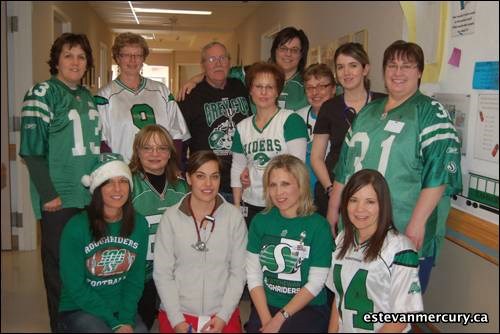It's called Releasing Time to Care and it is rolling out across the Sun Country Health Region in an organized fashion, according to the team leaders who gathered at Estevan's St. Joseph's Hospital last Thursday afternoon.
The project that got its start a few months ago at Weyburn General Hospital, was 小蓝视频 introduced more formally to the lead team at St. Joseph's. This team will begin the process of increasing efficiency throughout the hospital starting in Ward A on the second floor of the facility.
"It will involve about 40 people in the first wave," said Cheryl Harrison, nurse manager, and one of the team leaders in Estevan along with Tarja Kleemola.
Releasing Time to Care is about creating improvements in how things are done in each sector of an acute care facility so that more time can be spent with patients and their families. The program is designed to help nursing staff reduce their activities that keep them away from bedside care. Those distractions could include such things as running around a ward looking for certain pieces of equipment or materials, duplicated paperwork, unnecessary communication disruptions, waiting for results or support staff, plain and simple interruptions during the course of the working day and excessive walking to retrieve supplies.
The project begins with the collection of base line (benchmark) statistics, said Felecia Watson, the regional director for quality improvement for Sun Country, who was joined by Wanda Miller, the team development facilitator for the Estevan launch.
Once the current staffing movements are recorded by means of electronic monitoring devices that require the subject to check in quickly (electronically) every 22 minutes, then the search for efficiencies will begin Dec. 8.
Other key members of the project include Mary Anne Veroba, director of patient/resident care at St. Joseph's, and Gisele Eggen, unit clerk, who will act as a team leader along with Kleemola and Harrison.
"The program started in June in Weyburn and the first team there is already noticing marked improvements," said Watson.
"It's a way to help front line staff help the patient and their families," said Harrison.
The exercise should help each ward in the hospital become better organized which, in turn, frees up time to do more vital work.
"Each team will identify where the weaknesses are and then go forward accordingly," said Watson. "Whether it's medications, doing rounds, whatever the data tells them."
"We already know where some of the frustrations are," said Harrison, "but this project will clearly identify them in this pre-implementation stage that will take about six weeks, and then we'll work on eliminating them."
Miller said the idea is to have all the program modules introduced and in progress throughout the hospital within the next 10 to 12 months.
"The first team (Ward A) will roll out the program for the others, adding new people to the team as we go," said Harrison.
All acute care facilities in Sun Country are to be fully engaged in the program by 2013.
"It adds up to more patient safety and more time for them too," Harrison added.
"We want the public to understand what it is and why we're doing it," said Watson.
Harrison said some team members will receive additional training at an upcoming seminar in Saskatoon and that will also give the local members a good understanding of how they are doing in comparison with others who are undergoing the same process throughout the province.
In the second phase of the project, once the benchmarks are established, Harrison said the team members will find out how they're doing in terms of ward organization, how they're doing with regards to patient status and communication and then set out to select what route they'll take for the third, fourth, fifth, sixth steps and so on, until the complete spectrum is covered.
As an example, she said, the third step the team might identify as one they will tackle, might be patient hygiene, or it might be patient observation techniques or perhaps overall nursing procedures or how the ward keeps its records. The focus might then switch to meals and medications or how each shift handover is handled.
"How do you feel at the end of the day and what do you want the patients to say about you and the service they got when they go home?" said Harrison.
That will be the bottom line.
By establishing the benchmarks and then addressing them, Harrison said that such things as daily interruptions will be recorded and the reasons why that person was disrupted will be noted and the charting graphs will clearly show where improvements can be made.
The program, which began in England and has proved to be successful there, will become a part of the Saskatchewan acute care system within the next 36 months and Estevan's hospital will have been among the first to embrace the new efficiencies.




